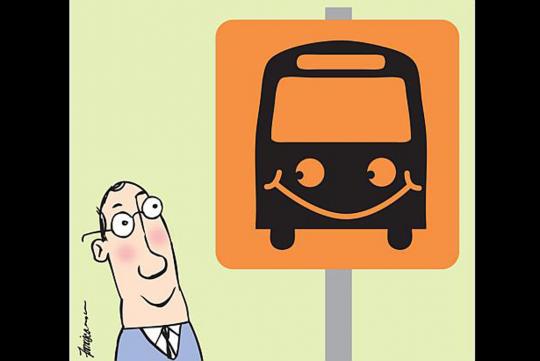Think big and bold to boost bus services
Think big and bold to boost bus services

The Government has been stepping up efforts to improve bus service standards.
It started with the announcement in 2012 of a $1.1 billion Bus Service Enhancement Programme, under which the state finances the purchase and operation of 550 additional public buses. By the end of this year, all of the new buses will be on the road.
That was followed recently by a carrot-and-stick scheme to incentivise operators to keep "excess waiting time" to a minimum. The plan, the first of its kind here, will start with a two-year trial involving 22 services.
And next year, a sophisticated satellite-tracked system that will forecast to the minute when a particular bus will arrive at any given stop.
These are good moves, to be sure. But are they enough? More to the point, do they make a difference where it matters most: to commuters' bus journeys?
Consider for example that the carrot-and-stick scheme - called the Bus Service Reliability Framework - will involve only 8 per cent of services here. And it is only a trial.
Secondly, a satellite-tracked bus arrival forecasting system may be a technological marvel, but nothing beats having buses stick to a dependable bus timetable - whether the timetable is printed on plain paper or is available as a sophisticated app.
Mr Bruno Wildermuth, a respected industry consultant, says a published bus timetable is a must. That way, commuters can plan their day effectively. And regulators can gauge the service of operators.
Mr Wildermuth points out that bus timetables are common in many developed countries, including Japan, Australia, Scandinavia, Germany and Switzerland.
"Not everyone has a computer or a smartphone," Mr Wildermuth says, referring to bus arrival information systems that smartphone users can tap on.
"Secondly, how do I plan for a meeting in town? How do I plan my transfers if there isn't a timetable?"
He says that in Zurich a commuter can plan his journey down to the minute because buses there are required to run to a strict timetable.
In Tokyo, buses are so reliable that commuters can set their watches to a service.
National University of Singapore transport economist Anthony Chin agrees that a fixed timetable is preferred.
"What you need is certainty in arrival times according to a published schedule," he says.
The Land Transport Authority, however, seems to think that timetables are needed only for services that are less frequent.
An LTA spokesman says that when the new arrival system is ready next year, it will be able to provide updates on bus arrival information "so that commuters have more predictability on the arrival of their bus service".
The LTA will then consider the merit of providing timetables "for low-frequency bus services".
This is puzzling. Why not a timetable for all services? After all, the planners have access to a wealth of commuting information through the ez-link card. With some planning, it would be possible to come up with a bus timetable that will benefit the commuter and is feasible for the operator.
So while a satellite-tracked arrival system sounds sophisticated, it is of limited use to commuters who cannot plan journeys in advance.
In fact, LTA and bus planners should go beyond buying buses and tracking journey times. For a move that would have a more significant impact on the daily bus commute, they should revisit the plan to redraw Singapore's bus routes. Mr Raymond Lim made the LTA the central bus route planner when he was transport minister.
The idea was for it to come up with a hub-and-spoke network that is optimal, efficient and not necessarily profit-motivated.
But the changes have been slow in coming. And many bus routes that are extraordinarily long remain. Take Service 196 for instance. It plies between Bedok in the east and Clementi in the west. But most commuters on it actually travel between the city and the two towns. Why not split it into two shorter routes?
Dr Park Byung Joon, head of the Master of Science programme in urban transport management at UniSIM's School of Business, observes that long bus routes are not desirable.
"It has been empirically proven that the longer the bus route, the poorer the bus reliability," he notes. "The Seoul bus reform implemented in 2003 divided Seoul into eight zones and most of the bus routes ran only within a zone.
"Since bus routes became relatively short, the reliability naturally improved."
The Seoul bus reform has been hailed as a success story by transport experts, where decisive government intervention turned around a messy industry.
Then there is the question of whether Singapore's fleet of 4,000-plus public buses is well utilised.
Mr Wildermuth observes large numbers of buses at interchanges - even during peak hours. "Drivers should take tea breaks, not buses," he asserts. He believes, with better manpower planning, operators could do a lot more with their fleets.
Dr Park agrees. "It is well established that simply adding more buses to the fleet is not an effective way of improving bus reliability," he says. "It must come with other measures."
Truth be told, the bus commuter's lot has generally improved. This is especially so for those who use services such as 72, 106 and 922, which got more buses under the Bus Service Enhancement Programme. Many also benefit from new City Direct express services.
But some services are below par. Service 147 has waiting times of as long as 30 minutes; Service 7's departure times from Clementi interchange are patchy; and the infamous 190 made headlines last October when a commuter complained that she could not get on it for 13 times.
To fix the industry conclusively, perhaps bigger, bolder steps need to be taken.
-- ST ILLUSTRATION : Manny Francisco
by Christopher Tan



4 Comments
Recommended Comments
Create an account or sign in to comment
You need to be a member in order to leave a comment
Create an account
Sign up for a new account in our community. It's easy!
Register a new accountSign in
Already have an account? Sign in here.
Sign In Now